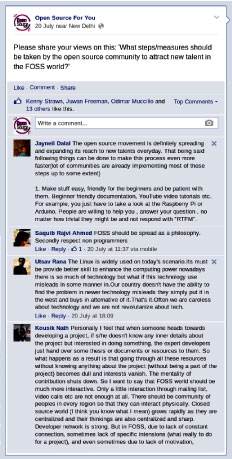 Industry experts share their views on what’s holding back raw IT talent from exploring the world of FOSS and what could be done to attract it.
Industry experts share their views on what’s holding back raw IT talent from exploring the world of FOSS and what could be done to attract it.
Businesses in India are waking up to the potential of Free and Open Source Software (FOSS) as a sustainable and robust revenue model, and that explains the large-scale open source software deployments across varied verticals. While the open source ecosystem has redefined the Indian enterprise IT market, the big question is: Is there enough FOSS talent in India? Or are there too many bottlenecks within the ecosystem that are stopping the raw IT talent from exploring the world of FOSS?
Most FOSS advocates and industry experts believe that though open source adoption in the Indian IT landscape is growing at a rapid pace, there are quite a few stumbling blocks that are impeding the development of a steadfast FOSS ecosystem and, in turn, failing to attract the raw IT talent into this open domain. K C Ramakrishna, CEO and founder of R-Knowsys Technologies, a premier FOSS enabler and provider in Hyderabad, shares, “Contributing to FOSS involves a reasonable amount of investment in terms of time and effort. Indian developers (even most international developers) do not see the benefit of such an investment. Will their salaries improve as a result? Unfortunately, not. Only product-based firms and high tech companies value those skills. Most consulting firms do not care about them. Unfortunately, most developers in India do not know how to leverage their contributions to FOSS to get better jobs or build themselves a better career.”
Lack of awareness about the benefits of open source and the rapid adoption of proprietary software are the major hindrances in the development of a full-fledged open source ecosystem. Madhav Kobal, director and chief technology officer at OS3 Infotech Pvt Ltd, yet another open source solutions provider based in Mumbai, says, “When it comes to development, most Indian consumers are generally not aware of the options available in open source. And the Indian industry has a tendency to rely on existing proprietary models for business rather than explore other open options. Naturally, the demand for FOSS is relatively low in India. But the good thing is Indian enterprises are realising the power of FOSS, and are now gradually using it for their mission-critical applications.”
A common misconception is that if one is to create an ecosystem that supports FOSS, all that one does also has to be open source. But while that would be the ideal scenario, there is no compulsion to do so, feels Arun Kumar, general manager, Red Hat India. “We have seen many examples in the ecosystem where participants also thrive with the non-FOSS solutions. FOSS gives a leg-up to participants in the ecosystem to create and exploit great ideas that will be hard to implement in a non-FOSS system. I feel some of the biggest obstacles to the growth of Linux and FOSS in the country are the high piracy levels of proprietary software, the perceived lack of maturity of open source platforms, the non-availability of trained personnel with the right skill sets, and the lack of promotion for open source technology. However, there are practices and policies that are changing towards more open source adoption across both the public and private sectors.”
It wouldn’t be right to assume that there is a shortage of FOSS talent in the country. The growing demand for open source technologies has prompted Red Hat, the leading provider of open source software solutions, to expand globally and in APAC. The fact that Red Hat has its second largest R&D facility outside North America in India is a testament to the strength of the talent available here. “India boasts of the largest pool of Red Hat Certified Engineers (RHCE) and these skills are impacting FOSS deployment globally. It is not just professional talent in FOSS right now, but a growing community of future open source talent in the making as well,” adds Kumar.
Industry experts believe that the FOSS ecosystem will take time to mature and this will happen once the user base in India grows to an optimum level. It’s also important to overcome issues like the lack of advocacy and awareness, non-availability of trained skill sets and more.
So how does one remove these obstacles and attract the raw IT talent to take the plunge into the FOSS world?
One can innovate, tinker with, and create new things with open source, and the raw IT talent must be made aware of all these benefits, feels K Subramani, vice president, Security and Risk Management at IBM. “The whole idea is to make FOSS lucrative for the young IT talent. More start-ups based on open source should be encouraged in India and they should be given a discount on taxes. The Indian government should establish a centre of technology for smart young minds so that they can exercise their creative skills on FOSS and come up with their innovations. This will definitely help in promoting FOSS and tapping new talent,” explains Subramani.
Chandresh Adhiya, chief executive officer of Qlogy, another open source solutions provider, says, “IT institutes and training providers should design a curriculum that is at par with the industry standards to attract the new talent pool and help them get jobs in the FOSS domain. A good curriculum on FOSS will help raise awareness levels within the students community too and, in turn, help in the development of the FOSS ecosystem. The government should also play a major role at the adoption and contribution level in order to make India more FOSS-friendly. It should encourage the creation of a supportive ecosystem for the FOSS companies to excel.” The good news is state governments like Kerala are making efforts not only to promote FOSS but also drive its adoption.
Aditya Mehta, chief executive officer of WickedLeak, comes up with an interesting angle. The advent of Android (which is open source) as a mobile OS has helped raise the level of awareness about FOSS to some extent, he feels. “Android has emerged as an open source champion and, naturally, people are becoming aware of the benefits of FOSS through this. The next few months will see the advent of more open source mobile operating systems like Tizen and Mozilla Firefox, and this will enhance the chances of the young IT talent pool working in these areas. I also feel that open source is not being promoted in the rural areas. I feel handset manufacturers should work with service providers to roll out cheaper Android devices in the rural areas. Who knows, one day we could have open source developers from remote places?” says Mehta.
A few open source companies are making an effort to promote FOSS in the country. For example, since 2011, Red Hat has ramped up activities for the developer community across APAC. With a rapidly growing number of developers coming from India, it has brought several large scale and notable developer events to India. These include FUDCon (Fedora Users and Developers Conference) and JUDCon (JBoss Users and Developers Conference). It also ensures that the latest e-resources, such as webinars, data sheets and videos, are publicly available. These assets are useful to customers, developers and students alike, and can be found on www.redhat.com or via social media channels such as youtube.com/RedHatVideos.
Red Hat also supports schools with a fully Web-deployed and Web-managed program, and outfits them with the technology and technical expertise to start and sustain a Linux curriculum. The Red Hat engineering team works closely with local educational institutions, research bodies and the agencies involved in formulating standards. The engineering team collaborates with various organisations to ensure the proliferation and adoption of Open Standards in every aspect of interaction.













































































